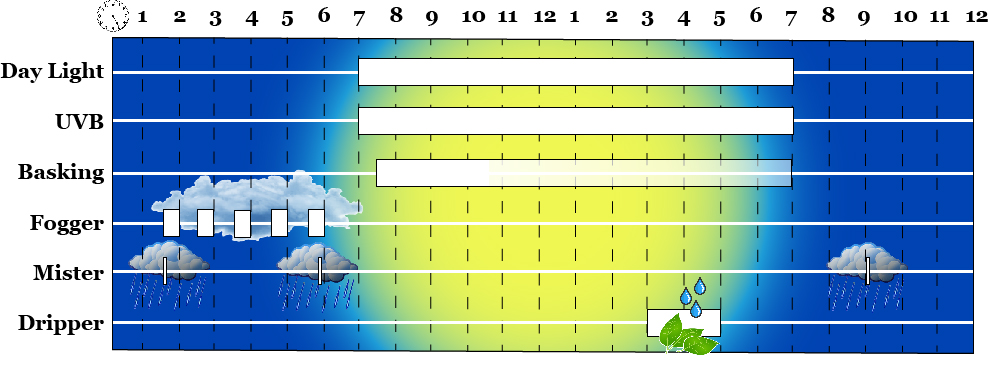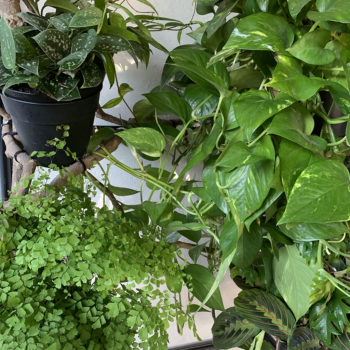What is the Chameleon Environment?
One of our greatest challenges is to extract the weather patterns the chameleon has evolved to rely on and recreate them in our small cage area. In this module we will review the conditions we are trying to create. The above graphic shows a 24 hour period in your chameleon’s life and contains the most important elements.
Chameleons live in many different biotopes and environments from the heat of the Namib desert to the the deep forest to the frigid mountain tops. It is imperative that you know what conditions your chameleon needs. The standard cycle presented here will be able to be used with any of the chameleons. What will change is the ambient temperature and humidity levels. But all chameleons will have a humidity spike/temperature dip at night and a humidity drop/temperature increase during the day. What changes is the magnitude of the dip and increase.
In this module we review topics surrounding weather and environmental conditions. We need to understand what we are trying to recreate before we start setting the equipment up to recreate those conditions! After this module, though, it is time to get our hands dirty and we will start building up our cage!
A Chameleon's Day
When we set up our daily schedule we are attempting to replicate the wild conditions that the chameleon has grown to expect. Of course, each 24 hours is a continuous flow, but let’s start at midnight.
Midnight to 6AM: Cool and Humid
At midnight the chameleon has been asleep for many hours. It is dark and, although the moon waxes and wanes, chameleons will seek out dark places to sleep. They see light of all colors just fine and any light can disturb their rest. This is why we do not use nightlights with our chameleons.
As the early morning progresses the humidity rises. Fog banks can start to form and the chameleon is breathing in moist air. This high humidity forms an important part in their natural hydration. We all lose moisture when we breathe and this high nighttime humidity keeps the chameleons from waking with a sense of being thirsty.
With the cool nighttime temperatures, the dew point is reached and the moist air condenses on the plant leaves which creates a layer of dew upon the world when the chameleon awakes. Any sense of dehydration can be taken care of by licking up the dew around him. This, combined with moisture from their food, makes up the hydration cycle for chameleons. While we think of rain being the source of hydration, rain is only available reliably through the wet season. The chameleon must be able to get enough hydration during the dry season when it doesn’t rain for months. It is true that the nights are not always high in humidity and there isn’t always dew on the leaves in the morning. And, there are reports of chameleons falling out of the trees dying of dehydration. So our challenge is to find the balance of what they need between too much and too little.
As we head towards sunrise, the fog will thin and the glow on the horizon will wake the chameleon.
Morning 6AM to 10AM: Time to warm up
As the sun peaks over the horizon the chameleon is waking up and looking to move to a suitable basking spot. The chameleon’s body has rested in the cool of the night and now it is time to warm up and hunt.
The world has a layer of dew and the chameleon has an opportunity to lick any water up that he needs to replenish his stores. Our chameleon moves itself into a position where it can catch the first rays of sun. Chameleons show an amazing ability to move and feed at low temperatures, but everything works better when warmed up! Early morning is when we see our chameleons basking. This is significant because by time the sun is heading to its height in the sky the chameleon has warmed up and is actually retreated back into the protection of the shady bushes. Reports from the field share that, on a typical clear day, chameleons will be basking only during the first hours of morning when the UV Index is low. By time the UV Index climbs past 2 or 3, the chameleon has retreated back into the bushes. It is important to take into account behavior, because seeing on a weather station that the UVI in the native chameleon lands are 12 could lead you in the wrong direction. There is no reason to recreate a UVI of 12 (for example) in the small confines of a cage! Although our goal is to recreate the natural conditions, UVB levels are one place where we must be very careful as to how we interpret weather data.
Afternoon: 10AM to 5PM: The heat of the day
The middle of the day is actually the most boring part of the chameleon’s life. During this time they will be in the dense leaves trying to stay out of the blasting sun and be hunting or waiting in ambush.
Afternoon: 5PM to Midnight: Turning in for the night
With the approach of evening, our chameleon will come out and hunt at the edge of the bush. As the sun retreats towards the horizon, the chameleon will make its way to its chosen sleeping spot. This sleeping spot will be in a safe location. It will be either hidden in leaves, hidden amongst thorns, or out at the end of a long thin branch. There will be some way that the chameleon will want to feel safe as it goes to sleep.
Husbandry in Transition: Misting During The Day
It is worth directly address the practice of misting during the day. It is has been common to mist multiple times during the day and this advice continues to be given. This comes from the time when we in the community believed that chameleons got all their hydration from rain. Thus we rained on them during the day when they were awake to drink. And since they always drank we continued to rain on them until they had their fill.
There are many factors at play that are worth addressing and guiding the community to a better way. We were producing a humidity cycle that was opposite to what chameleons expected. We were forcing the day to be high in humidity and over the night we would allow our cage to dry out. So the chameleons would dehydrate over the night and be thirsty during the day so we would witness confirmation that they needed more water. And we didn’t consider that chameleons can drink reflexively so, while we were forcing them to sit under mist we did not know how much drinking was from thirst and how much was just an automatic reaction.
I remember years of discussing with my fellow keepers the contradiction of knowing that chameleons survived dry seasons without rain for months, yet couldn’t seem to get through the day in captivity without gulping water. Getting the hydration cycles correct has answered these questions. By keeping humid nights and dry days chameleons are hydrated without that constant misting of the cage during the day.
The natural hydration cycles will be shared and explained in detail in the coming modules. The community is slowly coming around, but it is not yet universally accepted. Things that change the way we have done things for years should be viewed with skepticism, but the proof of effectiveness of the natural hydration method is there for anyone to test for themselves.
A Chameleon's Year
Chameleons come from a wide range north and south of the equator and seasons change accordingly. Those nearest to the equator experience we and dry seasons while those on the Southern borders of Europe and in South Africa experience a winter that many of us are familiar with. The Bradypodion in South Africa are one of the species that deal with snow!
It is still unknown how important seasonal variations are to the health of our chameleons. It is definitely of importance to breeders as there are behavioral triggers that go along with changes in seasons. These are to ensure that the babies hatch during the most advantageous times during the year.
Altitude and MicroClimates
Altitude plays a major role in what the optimal conditions are for a chameleon. The higher in altitude the more UVB the chameleon is exposed to and the greater the difference between night and day temperatures. This plays out most famously in the Jackson’s Chameleon that requires a night time drop of twenty or so degrees Fahrenheit to maintain optimal health. This is a case of chameleons not only adapting to their environment, but becoming dependent on it. And we are still learning about the depth of dependance on higher UVB levels in higher altitude chameleons. The most dramatic is the Trioceros hanangensis which will not color up properly until exposed to the high UVB levels of its home on top of Mt. Hanang in Tanzania. We continue to explore these unknown corners of chameleon husbandry!
Perhaps the most common misconception in the chameleon world relating to habitat is the environment that the Veiled Chameleon lives in. A look at its native Yemen will give the impression that this chameleon lives in a harsh environment. The truth is that they live in Wadis, or valleys, during the wet season which are temporary lush oases. It is true that when the dry season comes around, these oases become harsh and barren, but this is what kills off all the veiled chameleons. So, the conditions so many people attribute to the veiled chameleon are actually what kills them. Thus the danger of not knowing the context in which to interpret the data being gathered.
Navigation
This module is part of a class on Setting Up Your Chameleon’s Cage where you learn how to build up a complete chameleon environment from start to finish. From this point you can either go back to the home room and see the other modules in this class or go on to the next module where we discuss the life of our cage – Plants! Live plants are what make the cage an environment. Some people have difficulty keeping plants alive, but we will fix that!




